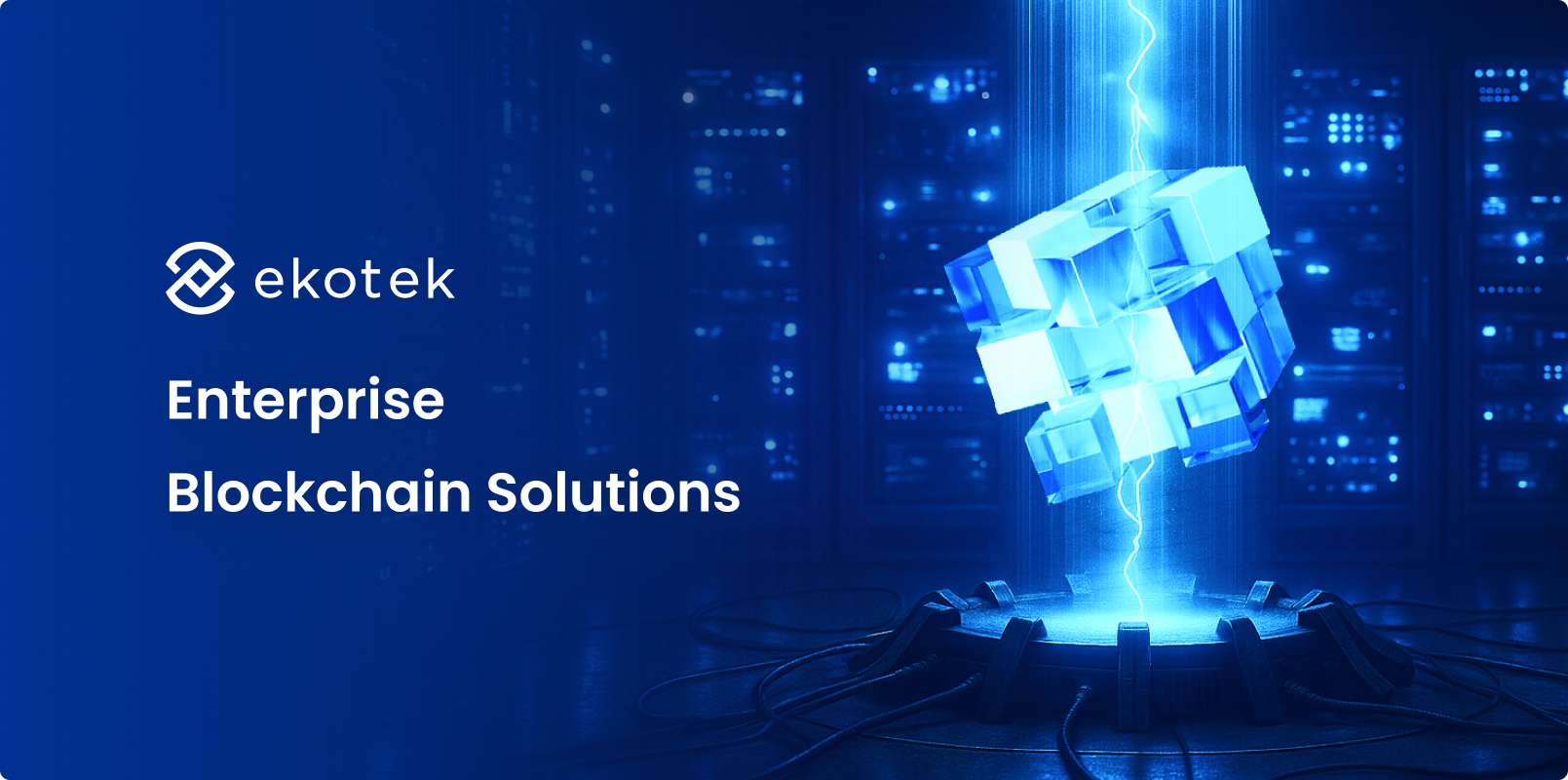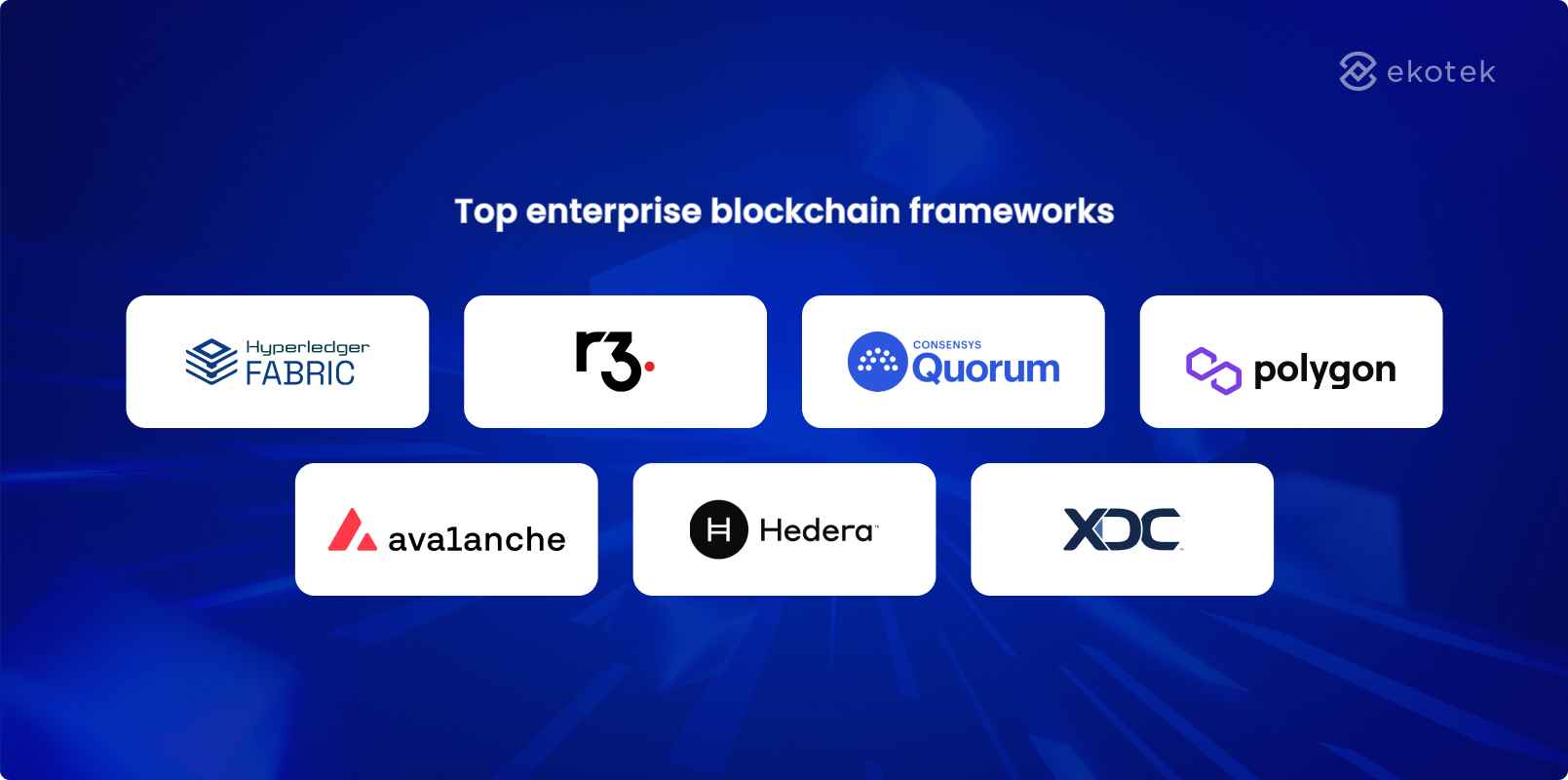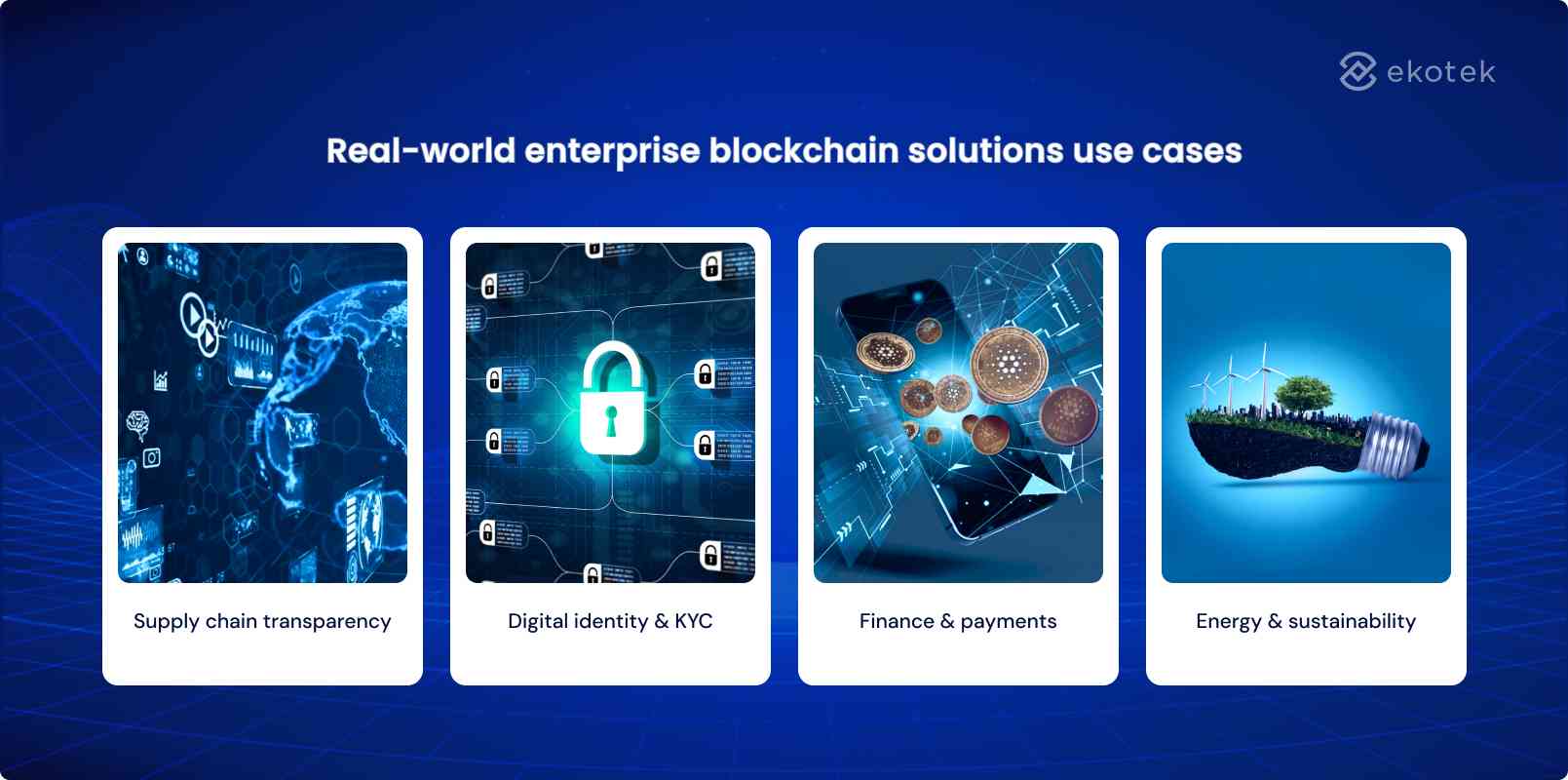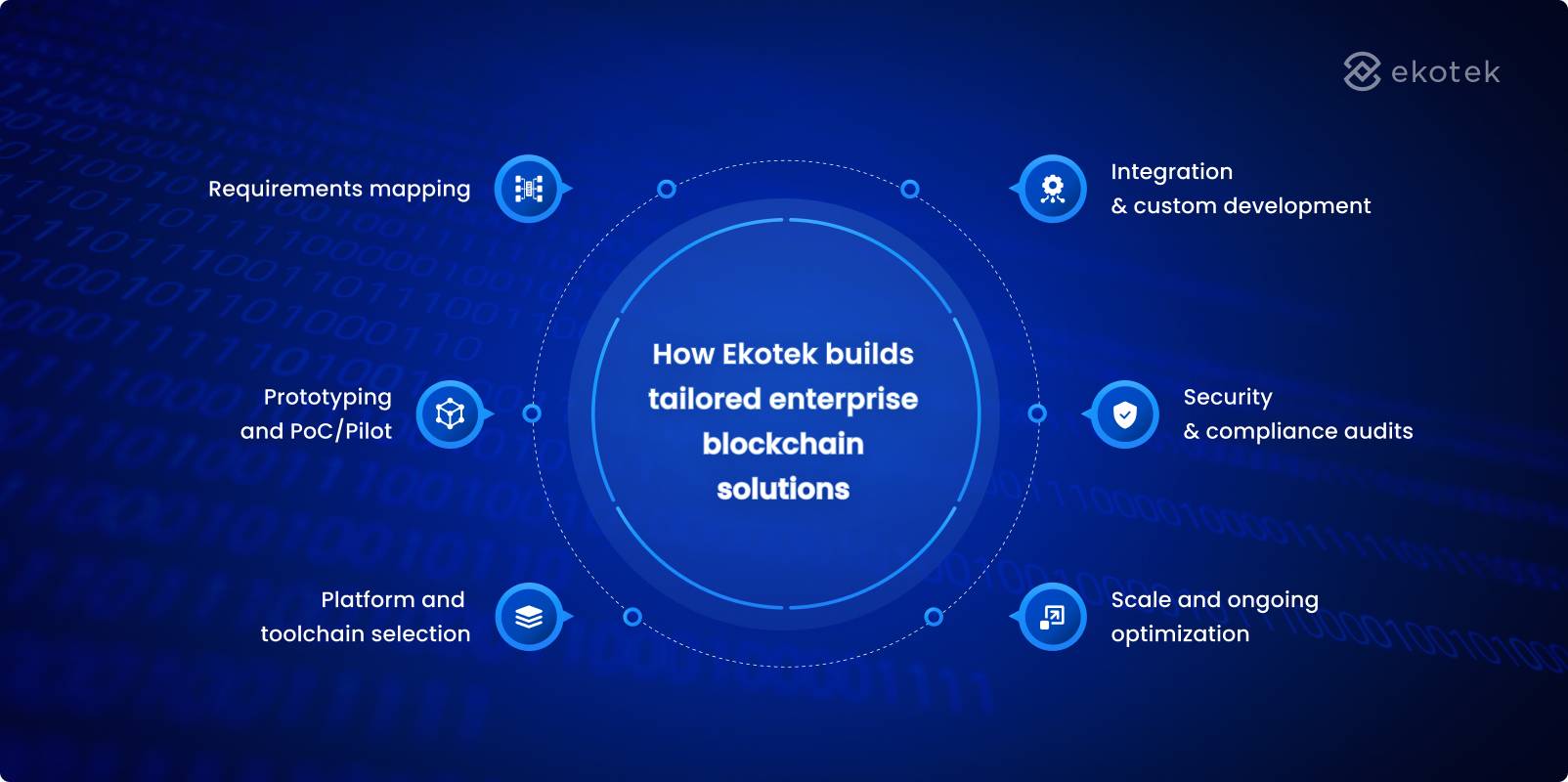
- 1
- 2
- 3
- 4
- 5
- 6
- 7
- 8
- 9
- 10
Introduction: From concept to enterprise blockchain solutions reality
Enterprise blockchain solutions have evolved from early experimentation into mission-critical infrastructure for modern organizations. What once started as a proof of concept is now driving real-world impact across industries, enhancing security, transparency, and operational efficiency.
As enterprises grow, they face mounting challenges in data security, system integration, and process visibility. Blockchain bridges these gaps, transforming isolated “pilot projects” into scalable, value-driven systems that power digital trust and long-term innovation.
This guide cuts through the noise, exploring why enterprise solutions are fundamentally different from public blockchains and how to move from proof-of-concept to large-scale, measurable impact. You’ll find real case studies, actionable checklists, and a pragmatic roadmap to take your blockchain program from pilot to production-ready business infrastructure.
Why enterprises need a different kind of blockchain
While public blockchains were designed for openness and decentralization, enterprises need blockchain solutions that prioritize security, control, and interoperability. Their operational demands go far beyond what public networks can offer.
Organizations must address key requirements such as:
-
Privacy and access control to protect sensitive business data
-
Scalability and performance to handle enterprise-grade workloads
-
Integration with legacy systems such as ERP, CRM, and cloud infrastructure
-
Regulatory compliance and governance to meet industry and legal standards
As a result, enterprise blockchain solutions are built on specialized architectures and management models that ensure controlled participation, predictable performance, and end-to-end accountability. These platforms combine the trust of blockchain with the stability and compliance enterprises require to operate at scale.
Key differences: Public vs. Enterprise blockchain solutions
| Feature | Public Blockchain | Enterprise Blockchain (Permissioned) |
|---|---|---|
| Transaction Speed | Low – Congested/shared | High-tuned for enterprise needs |
| Access Control | Open | Role-based and granular |
| Compliance | Limited, general | Structured, sector-specific |
| Governance | Decentralized, slow | Customizable, rapid response |
| Data Privacy | All-chain visibility | Selective and auditable |
| Energy Efficiency | Often high (Proof-of-Work) | Optimized for business (PBFT, RAFT etc.) |
💡 Discover how enterprises gain real value with Blockchain for Business
Core components of enterprise blockchain solutions
Behind every successful enterprise blockchain solution lies a robust architecture designed to balance trust, control, and efficiency. Unlike public blockchains, these platforms are engineered for enterprise-grade performance and governance. The following components form the foundation of most modern implementations:
Permissioned networks
Enterprise blockchain networks are typically permissioned, meaning only authorized participants can join and transact. This model ensures data privacy, secure identity management, and restricted membership, making it suitable for regulated industries such as finance, healthcare, and supply chain.
Example: In a global supply chain, manufacturers, distributors, and retailers can share shipment data through a permissioned blockchain. Each party sees only what they are authorized to view, improving transparency while maintaining confidentiality
Consensus mechanisms
Unlike energy-intensive public consensus models, enterprise systems use performance-optimized algorithms such as PBFT (Practical Byzantine Fault Tolerance), PoA (Proof of Authority), or Raft. These mechanisms deliver faster transaction throughput and lower latency, ensuring reliability in mission-critical environments.
💡 Explore how innovation is reshaping industries through Blockchain Technology and Business Models
Smart contracts
Smart contracts enable business logic automation within the blockchain network. They streamline workflows, enforce business rules, and reduce manual intervention and human error, driving operational efficiency and consistency across departments or partner organizations.
Governance & compliance
Enterprise blockchain solutions embed governance frameworks that define how nodes are managed, decisions are made, and compliance is maintained. This ensures transparent, auditable operations aligned with corporate policies and regulatory requirements, a key factor for enterprise trust and adoption.
Example: In the healthcare sector, governance policies can define who is allowed to upload, view, or update patient data on the blockchain, ensuring both collaboration and compliance with privacy regulations like HIPAA or GDPR.
Interoperability
True digital transformation requires integration, not isolation. Modern enterprise blockchains support interoperability, connecting seamlessly with existing enterprise systems (ERP, CRM, cloud platforms) or even other blockchain networks. This enables end-to-end visibility, unified data flows, and stronger collaboration across ecosystems.
Example: A logistics company could integrate its blockchain platform with an SAP ERP system and a partner’s Hyperledger network to synchronize order data, shipment tracking, and customs documentation in real time
Top enterprise blockchain frameworks & how they differ
 Selecting the right technology foundation is crucial when developing enterprise blockchain solutions. Each framework has unique strengths, from modularity and privacy to scalability and energy efficiency, making it suitable for specific business and regulatory needs.
Selecting the right technology foundation is crucial when developing enterprise blockchain solutions. Each framework has unique strengths, from modularity and privacy to scalability and energy efficiency, making it suitable for specific business and regulatory needs.
Below are the leading frameworks powering today’s enterprise blockchain landscape
Hyperledger Fabric
Developed by the Linux Foundation, Hyperledger Fabric is one of the most mature and trusted platforms for enterprise use. It’s designed to be modular, flexible, and highly secure, ideal for large organizations managing complex data flows.
Key features:
-
Modular architecture: Enterprises can configure consensus, identity management, and ordering services independently.
-
Private channels: Allow confidential transactions between specific parties on the same network.
-
Chaincode flexibility: Supports common programming languages (Go, JavaScript, Java).
-
Enterprise integrations: Seamlessly connects with ERP systems, IoT devices, and cloud platforms.
-
Strong community & vendor support: Backed by IBM, Oracle, and many enterprise solution providers.
Real-world example: IBM Food Trust uses Hyperledger Fabric to track food products from farm to shelf, improving traceability and ensuring data privacy between producers, distributors, and retailers.
R3 Corda
Corda was built specifically for the financial services industry, emphasizing privacy, compliance, and contract-based workflows.
Key features:
-
Confidential point-to-point transactions: Ideal for banks, insurers, and trading platforms.
-
Smart contracts with legal enforceability: Link business logic directly to legal prose for auditability.
-
Regulatory alignment: Built for environments where compliance (KYC/AML) is non-negotiable.
-
High throughput for settlement workflows: Optimized for complex multi-party financial agreements.
Quorum (ConsenSys)
Originally developed by J.P. Morgan, now maintained by ConsenSys, Quorum extends the Ethereum ecosystem with enterprise-grade privacy and performance.
Key features:
-
Ethereum compatibility: Supports Solidity smart contracts and existing Ethereum tools.
-
Private transaction manager (Tessera): Keeps sensitive business data off the public ledger.
-
Multiple consensus algorithms: Includes Raft and Istanbul BFT for performance tuning.
-
Integration-ready: Works with ConsenSys tools like Codefi and Infura for asset tokenization and infrastructure scaling.
Polygon CDK
Polygon Chain Development Kit (CDK) enables enterprises to create customized Layer 2 blockchains that are fully compatible with the Ethereum ecosystem. It’s ideal for organizations seeking scalability and interoperability within a familiar EVM environment.
Key features:
-
Build dedicated Layer 2 networks tailored to specific use cases (supply chain, loyalty, finance).
-
Inherits Ethereum security, while dramatically lowering transaction costs.
-
Native interoperability with Polygon and Ethereum ecosystems.
-
Offers control over governance, performance, and economics.
Avalanche Subnets
Avalanche Subnets provide enterprises with the ability to run independent, customizable blockchains that still benefit from Avalanche’s high-speed infrastructure. They are particularly attractive for industries needing isolated governance or performance tuning.
Key features:
-
Each subnet operates as a sovereign blockchain with its own validator set and rules.
-
Near-instant finality and sub-second transaction speeds.
-
Multi-chain architecture enables parallel application ecosystems.
-
Well-suited for finance, gaming, and real-time data systems requiring low latency.
Hedera Hashgraph
Unlike traditional blockchains, Hedera uses hashgraph consensus, a different distributed ledger model optimized for speed, fairness, and energy efficiency. Managed by a governing council of global enterprises, it’s designed for large-scale corporate and government use.
Key features:
-
Handles over 10,000 transactions per second with predictable finality.
-
Energy-efficient and carbon-negative — aligns with ESG goals.
-
Governance Council includes Google, IBM, LG, and Standard Bank.
-
Ideal for digital identity, micropayments, and sustainability tracking.
XDC Network
The XDC Network combines public blockchain transparency with private-chain control, creating a hybrid environment ideal for trade finance and global supply chain solutions.
Key features:
-
Hybrid architecture supports both public and permissioned deployments.
-
Interoperable with legacy financial systems through ISO 20022 compliance.
-
Fast and cost-effective transactions suitable for global trade ecosystems.
-
Strong focus on cross-border data sharing and asset digitization.
Framework comparison table
| Framework | Consensus | Permissioning | Adoption | Compliance | Interoperability | Popular use cases |
|---|---|---|---|---|---|---|
| Hyperledger | PBFT/Modular | Yes | 1200+ projects | High (audit, privacy) | Supply chain, finance | Origin tracking, provenance |
| R3 Corda | Notary | Yes | 80+ major banks | Yes (finance regs) | Banking, insurance | Trade finance, payments |
| Quorum | Raft/IBFT | Yes | Capital markets, banks | Flexible (private txns) | Tokenization | Capital markets, fintech |
| Polygon CDK | Custom | Yes/Hybrid | Large-scale web3 | Evolving | Hybrid chains | Visa-scale retail, NFTs |
| Avalanche | Snowman | Yes/Hybrid | Global pilots | Growing | Web3, DeFi | Private/public custom chains |
| Hedera | Hashgraph | Hybrid | Public sector, supply chain | KYC/AML | Web3, API | Pharma, logistics |
| XDC Network | Hybrid | Yes | Government, supply chain | Sector-specific | API, ERP | Regulatory, traceability |
Which framework for which business?
- Finance: R3 Corda, Quorum
- Supply Chain: Hyperledger Fabric, Hedera/XDC
- Consumer/Retail: Polygon CDK, Avalanche Subnets
- Large-scale enterprise/regulated markets: Hyperledger, Corda
💡 Discover leading technologies driving enterprise innovation in Top 10 Blockchain Platforms
Real-world enterprise blockchain solutions use cases
 Supply chain transparency
Supply chain transparency
Blockchain enables end-to-end traceability of goods and materials, giving every stakeholder, from manufacturer to consumer, real-time visibility into the product journey.
Business impact:
-
Prevents counterfeiting and ensures product authenticity.
-
Enhances recall efficiency and compliance tracking.
-
Improves accountability among suppliers, distributors, and retailers.
💡 Learn how transparency and efficiency are transforming production with Blockchain in Manufacturing
Example:
In the premium beverages industry, counterfeiting is a constant threat, but Ekotek turned that challenge into an opportunity for an F&B company. With our digital authenticity solution, we combined blockchain and NFC tags to let consumers instantly verify product provenance from their smartphone. Discover how we built an end-to-end traceability system that not only protects brand integrity but also unlocks direct consumer engagement
Digital identity & KYC
Enterprise blockchain solutions provide secure, tamper-proof digital identities for individuals and organizations. This enables streamlined onboarding and data sharing without compromising privacy.
Business impact:
-
Enables secure verification of customers and partners across platforms.
-
Reduces KYC/AML duplication and fraud risk.
-
Enhances user control over personal data through self-sovereign identity (SSI) models.
Example: The European Blockchain Services Infrastructure (EBSI) initiative uses blockchain to support cross-border identity verification and diploma authentication within the EU
Finance & payments
Blockchain-based financial systems offer faster, cheaper, and more transparent B2B transactions, reducing intermediaries and settlement friction.
Business impact:
-
Enables real-time cross-border payments and asset tokenization.
-
Increases transparency in transaction auditing and reporting.
-
Lowers operational costs by automating settlement and reconciliation.
💡 Global transactions are being redefined through Blockchain in Cross-border Payments
Energy & sustainability
Blockchain supports carbon credit tracking, green energy certification, and transparent sustainability reporting, all critical for ESG-driven organizations.
Business impact:
-
Records energy generation and consumption with tamper-proof accuracy.
-
Facilitates peer-to-peer energy trading and renewable certificates.
-
Improves trust in carbon markets by preventing double-counting.
Example: Hedera Hashgraph powers sustainability projects for carbon credit issuance and verification, enabling companies to track and offset their environmental footprint.
Challenges in implementing enterprise blockchain solutions
Legacy system integration
Most enterprises rely on complex, decades-old infrastructure, ERP, CRM, data warehouses, and custom-built systems that were never designed for blockchain interoperability.
Key challenges:
-
Integrating blockchain with legacy data formats and APIs requires significant customization.
-
Synchronizing real-time data across on-chain and off-chain systems is technically demanding.
-
Migrating processes without disrupting ongoing operations demands strong change management.
Insight: The success of blockchain adoption often depends less on the technology itself, and more on how seamlessly it integrates with what already exists.
Governance & access management
Unlike public networks, enterprise blockchain solutions require controlled participation, defining who can read, write, and validate transactions.
Key challenges:
-
Establishing multi-party governance in consortiums is complex and politically sensitive.
-
Balancing transparency with confidentiality can lead to conflicting stakeholder interests.
-
Managing node operations, permissions, and consensus updates adds administrative overhead.
Insight: Effective governance isn’t just about technology, it’s about aligning incentives and responsibilities among all participants in the network.
Lack of standardization and skilled workforce
The blockchain ecosystem is still evolving, and standardized frameworks, protocols, and talent are limited.
Key challenges:
-
Enterprises struggle to find engineers experienced in blockchain architecture, smart contracts, and cybersecurity.
-
Varying standards across platforms (Fabric, Corda, Polygon, etc.) make interoperability difficult.
-
Unclear best practices for auditing and compliance create uncertainty for regulators and enterprises alike.
Insight: Training and cross-functional collaboration between IT, compliance, and operations teams are essential to bridge the knowledge gap.
💡 Partnering with experienced blockchain outsourcing vendors can bridge talent gaps and accelerate blockchain adoption
Initial deployment cost and time
Implementing enterprise blockchain solutions is not a quick win. The initial investment in infrastructure, development, and stakeholder alignment can be substantial.
Key challenges:
-
High upfront costs for architecture design, infrastructure, and integration.
-
Long lead times to achieve measurable ROI.
-
Pilot projects often stall before full-scale deployment due to unclear success metrics.
Insight: Enterprises that start with a clear use case and measurable KPIs are more likely to scale successfully and justify long-term investment.
How Ekotek builds tailored enterprise blockchain solutions
 We design tailored enterprise blockchain solutions that align with each client’s business goals, compliance requirements, and digital strategy. Our approach combines technical precision with practical implementation to ensure every project delivers measurable value.
We design tailored enterprise blockchain solutions that align with each client’s business goals, compliance requirements, and digital strategy. Our approach combines technical precision with practical implementation to ensure every project delivers measurable value.
Requirements mapping
Every project starts with a deep understanding of business objectives, existing infrastructure, and stakeholder needs.
We identify pain points, define data flow and access layers, and outline measurable success metrics that guide the entire implementation journey.
Prototyping and PoC/Pilot
Before full-scale deployment, Ekotek builds a proof of concept (PoC) or pilot system to validate technical feasibility and ROI.
This step helps clients visualize blockchain in action, from transaction flows to smart contract execution, reducing risks and ensuring stakeholder alignment early on.
Platform and toolchain selection
Ekotek selects the most suitable blockchain framework and ecosystem tools based on performance, privacy, and integration requirements.
Depending on the use case, we leverage platforms such as Hyperledger Fabric, Polygon, Corda, or Quorum, ensuring scalability, compliance, and interoperability with existing enterprise systems.
Integration & custom development
Our engineers connect blockchain layers with ERP, CRM, IoT, and cloud systems using custom APIs and middleware.
We also develop smart contracts, dashboards, and authentication modules to deliver seamless end-to-end workflows that fit naturally into the client’s digital ecosystem.
Security & compliance audits
Enterprise systems demand rigorous validation.
Ekotek conducts comprehensive security audits, code reviews, and compliance checks to ensure the blockchain network meets both internal governance and industry standards.
Scale and ongoing optimization
Once deployed, we continuously monitor and optimize network performance, enhancing throughput, upgrading consensus mechanisms, and integrating new modules as business needs evolve.
Ekotek’s long-term support model ensures continuous innovation and operational stability for every client deployment.
Our strengths in enterprise blockchain solutions
-
AI + Blockchain Synergy: We combine AI-driven analytics with blockchain’s data integrity to enable intelligent automation and predictive insights.
-
Multi-Industry Expertise: Proven success across finance, manufacturing, retail, and public sectors, adapting blockchain to diverse business realities.
-
Cost-Optimized Deployment: Modular frameworks and agile delivery reduce time-to-market and total cost of ownership.
💡 Unlock the potential of blockchain for your business with our expert Blockchain Development Services
Conclusion: From pilot to enterprise scale blockchain solutions
Blockchain is the foundation of trust, transparency, and efficiency for next-generation enterprises. What began as small-scale pilots is now powering mission-critical systems that reshape how organizations share data, verify authenticity, and collaborate across digital ecosystems.
Enterprises that move beyond experimentation and adopt enterprise blockchain solutions strategically are gaining a clear competitive edge, lowering costs, improving compliance, and unlocking new business models built on digital trust.
For organizations ready to take this step, having the right partner is key. Ekotek brings together technical depth, industry experience, and a results-driven mindset to help businesses turn blockchain from concept to enterprise-wide transformation. Our experts guide clients through every stage, from identifying high-impact use cases and building scalable architectures to integrating AI-driven analytics and ensuring compliance. With over a decade of experience and 200+ successful blockchain projects delivered globally, Ekotek helps enterprises accelerate adoption, minimize risk, and realize measurable value at scale.
FAQ on Enterprise blockchain solutions
1. How can blockchain create measurable business value for my organization?
Blockchain enhances data transparency, security, and process automation, leading to reduced operational costs, faster transactions, and greater stakeholder trust. When strategically implemented, it supports compliance, eliminates intermediaries, and enables new digital revenue models, turning technology investment into a long-term business advantage.
2. What makes enterprise blockchain different from public blockchain networks?
Enterprise blockchains are permissioned, secure, and designed for business governance. Unlike public blockchains, they offer controlled access, privacy, and integration with existing systems (ERP, CRM, cloud). This ensures predictable performance, regulatory compliance, and scalability across corporate environments.
3. How long does it take to implement an enterprise blockchain solution?
It depends on the project’s scope and complexity. A typical proof of concept (PoC) can take 6-10 weeks, while full-scale deployment may require 3-6 months. Ekotek accelerates this timeline through agile delivery, pre-built components, and deep experience integrating blockchain into enterprise workflows.
- 1
- 2
- 3
- 4
- 5
- 6
- 7
- 8
- 9
- 10